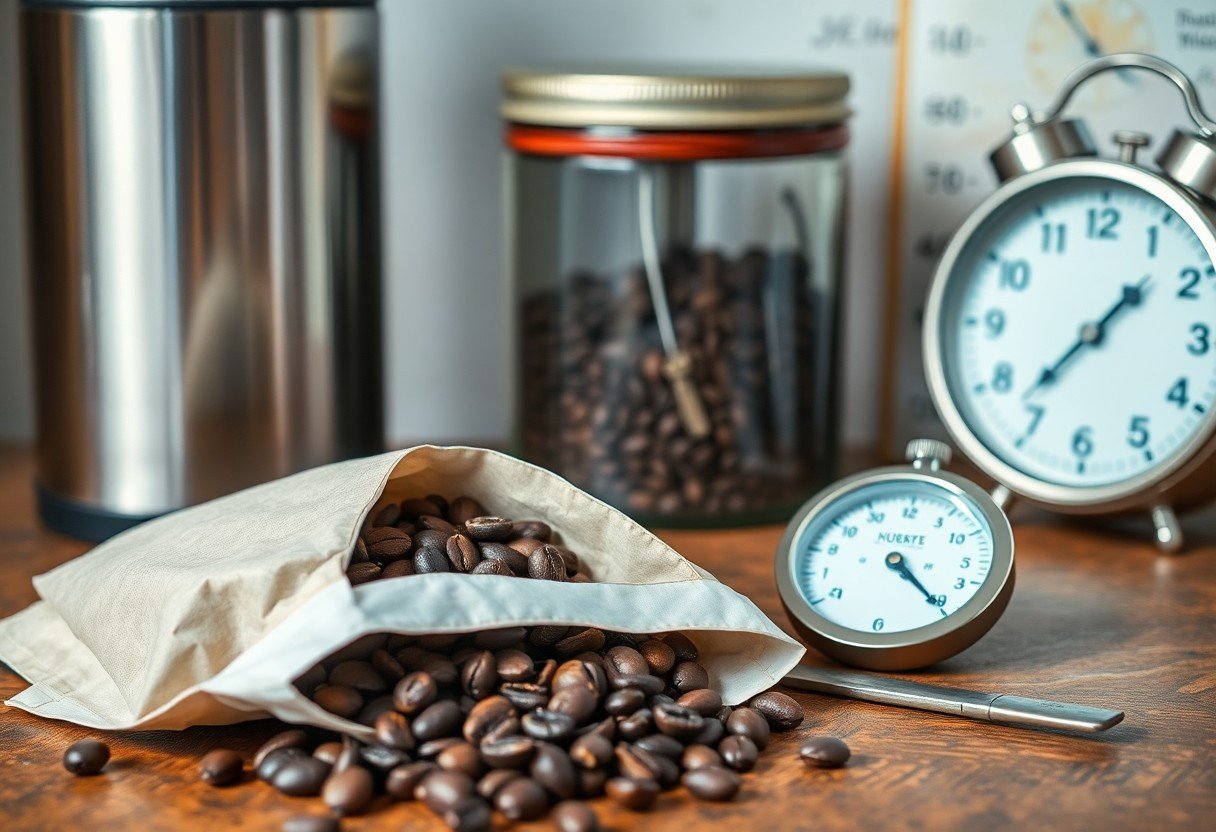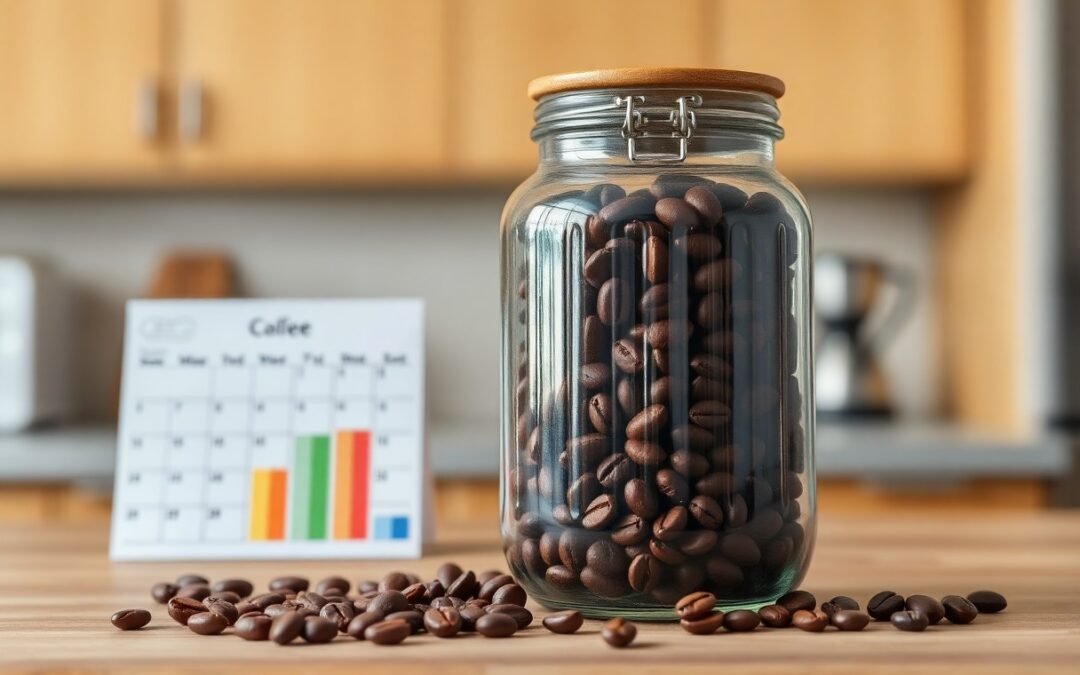With the right storage techniques, you can enjoy the best flavor from your coffee beans for an extended period. Understanding how long you can preserve your coffee without compromising its quality is important for any coffee lover. Factors such as the type of bean, storage conditions, and packaging play a significant role in maintaining freshness. In this post, you’ll discover expert tips on maximizing the shelf life of your coffee, ensuring every cup you brew remains rich and aromatic, no matter how long it’s been since the beans were roasted.
The Lifecycle of Coffee Beans: From Freshness to Staleness
The process of coffee beans transitioning from freshly roasted to stale is somewhat inevitable and can occur rapidly if not managed properly. Freshly roasted beans can take around two weeks to peak at their flavor profile before slowly declining in quality. After about a month, beans can develop off-flavors and lose their aromatic qualities, making it vital to consume them as quickly as possible, ideally within two to three weeks of roasting for the best taste experience.
The Journey from the Farm to Your Cup
Factors Influencing Bean Freshness
- Air exposure can propel staleness.
- Light can degrade oils and flavors.
- Temperature fluctuations may expedite freshness loss.
- Moisture may cause mold growth.
This combination of external factors and their interactions set the stage for coffee quality. For example, beans stored at room temperature in opaque, airtight containers typically last longer than those kept in clear bags at fluctuating temperatures. Paying attention to how you store your coffee can prevent unnecessary waste and ensure a richer flavor.
- Quality of roast influences longevity.
- Whole beans stay fresh longer than ground coffee.
- Time elapsed since roast matters significantly.
This awareness aids in making informed decisions about the freshness of your coffee. Ensuring they remain sealed, out of direct sunlight, and away from moisture will allow you to preserve the delicious nuances of your favorite brew, ensuring that every cup is as delightful as the last.
Optimal Storage Conditions: Your Coffee’s Best Friend
Creating the perfect environment for your coffee beans significantly enhances their longevity and flavor integrity. Proper storage conditions help slow down the aging process, allowing you to enjoy fresh-tasting coffee for as long as possible. Temperature, humidity, and light exposure all play vital roles in determining how long your beans maintain their freshness.
The Role of Temperature and Humidity
Temperature and humidity can dramatically impact the taste and aroma of your coffee. At elevated temperatures, the degradation process speeds up, while excessive humidity can lead to mold growth. The ideal storage temperature is between 60°F and 75°F (15°C to 24°C), with a relative humidity below 60%
Temperature and Humidity Effects
| Condition | Impact on Coffee |
|---|---|
| High Temperature | Accelerates degradation and flavor loss |
| Low Temperature | Can preserve freshness but may introduce condensation |
| High Humidity | Increases risk of mold and off-flavors |
| Low Humidity | Best for preserving flavor and preventing mold |
Ideal Containers for Preserving Freshness
Selecting the right container is imperative for keeping your coffee fresh once you’ve chosen the right storage location. Airtight containers made from opaque materials help shield your beans from light, air, and moisture, all of which can contribute to deterioration. Glass, ceramic, and certain plastics are excellent options, but make sure they are designed to seal tightly. Additionally, some specialized coffee canisters come with CO2 valves that allow excess gases to escape without letting air in, securing your beans’ freshness even longer.
The Critical Timeline: How Long Can You Really Go?
Coffee beans are best enjoyed fresh, with optimal quality diminishing significantly after roasting. Generally, you can preserve whole beans for up to six months past their roast date without serious degradation of flavor. However, by the three-month mark, you’ll begin to detect noticeable changes in taste and aroma, and after six months, the beans may lose their distinct characteristics. For the best experience, consuming your coffee within the first few weeks post-roast is ideal, allowing you to savor the vibrant flavors and aromas that make each cup special.
Freshly Roasted vs. Pre-packaged Beans
Freshly roasted coffee beans commonly yield the highest quality and flavor, ideally used within two weeks of roasting. Conversely, pre-packaged beans found on grocery shelves may have been stored for months, resulting in a loss of freshness long before you even make a purchase. While some vacuum-sealed packages claim extended shelf lives, they often sacrifice flavor for convenience. Your best bet is to seek local roasters and consume their products soon after roasting to enjoy the full spectrum of flavors.
Identifying Signs of Deterioration
Recognizing when your coffee beans have gone past their prime is crucial. If you notice a dull, flat aroma, or if the beans have turned excessively oily or dry, those are clear indicators of deterioration. Freshly roasted beans emit a vibrant aroma, while older beans may lack complexity. Additionally, taste tests revealing bitterness or an off-flavor can signal that it’s time to refresh your stock.
Identifying these signs is straightforward; for instance, if you open a bag and the scent is weak or non-existent, it’s a telltale sign that the beans are past their prime. Moreover, inspecting the surface for excessive oil can indicate that the beans are stale, affecting both taste and aroma. Quality matters, so trust your senses when determining whether it’s time to replenish your coffee supply.

Enhancing Longevity: Tips for Keeping Your Coffee Fresh
To keep your coffee beans fresh for an extended period, implement these effective tips:
- Store them in an airtight container.
- Keep them in a cool, dark place away from heat sources.
- Avoid storing beans in the refrigerator or freezer, as moisture can develop.
- Buy whole beans and grind them just before brewing.
Knowing how to properly preserve your coffee can significantly extend its freshness and flavor.
Common Preservation Methods: What Works
Various methods exist for preserving coffee, but some are more effective than others. Airtight containers are paramount for preventing air from deteriorating flavor, while darkness helps minimize exposure to light that can cause rancidity. Avoiding moisture by keeping the beans at a stable temperature is also imperative. Cold brewing is another popular technique, but for long-term storage, it might not be as practical compared to proper sealing and storage of whole beans.
The Myths Surrounding Coffee Preservation
Several misconceptions about coffee preservation can lead to subpar taste. One common myth is that refrigeration improves freshness; however, the opposite is true, as it can introduce moisture and odors. Another is that coffee never goes stale. In reality, coffee loses its peak flavor within weeks from roasting, making ideal storage imperative. People often believe freezing coffee is a good idea, yet this can diminish flavor due to condensation and freezer burn.
These myths can trick you into making poor decisions about storing your coffee. For instance, while freezing may occasionally be recommended for short-term preservation of more significant amounts, it compromises flavors for many enthusiasts. Recognizing that quality diminishes over time underscores the need for optimal storage practices. By shunning these myths and adopting proven methods, you can maintain that sought-after freshness. Taking the time to understand proper preservation will lead you to enjoy your favorite cup of coffee to the fullest!
The Quality Metric: Assessing Flavor and Aroma Over Time
Flavor and aroma are the prime metrics for assessing the quality of your coffee beans as they age. Freshly roasted beans produce a complex aroma and a bright flavor profile, packed with vibrant notes. Over time, exposure to air, moisture, and light can strip these characteristics, leading to a flatter and less enjoyable cup. Regularly inspecting your beans and conducting taste tests every few weeks can help you identify the subtle changes that signal an inevitable decline in quality.
The Sensory Impact of Aging Beans
Aging coffee beans significantly alters their sensory characteristics. Freshly roasted beans burst with aromas ranging from fruity to floral, complemented by a crisp acidity. As they age, these vibrant notes fade, replaced by dull, muted flavors. You might notice the once vibrant citrus notes vanish, giving way to an earthy, stale taste that is less appealing. Your coffee might begin to taste more bitter or lack the rich complexity you initially enjoyed.
When Quality Declines: A Personal Perspective
Observing coffee’s gradual decline in quality can be a nuanced experience. Initially, you might not detect significant changes in flavor, especially if you aren’t consuming fresh beans regularly. However, as time passes, the aroma starts to fade, and the flavors become muddled. One of my favorite blends, which once burst with lively berry notes, transformed into a disappointing brew that left me questioning my storage practices and purchasing habits.
This personal experience highlights the importance of freshness. After three months in an air-tight container, the blend I cherished lost its character; the once bright acidity now tasted flat, accompanied by a cardboard-like texture. By the six-month mark, the beans had become unpalatable. Monitoring your beans closely and understanding that even slight imbalances can lead to a significant quality drop will help you preserve the delightful experiences that good coffee offers.
Summing up
With this in mind, you can preserve your coffee beans for optimal quality by storing them in an airtight container in a cool, dark place for up to two to four weeks. Beyond that, while they may still be safe to consume, you may notice a decline in flavor and aroma. For long-term storage, consider freezing your beans, but ensure they are well-sealed to prevent moisture absorption. By following these guidelines, you can enjoy fresh and flavorful coffee every time you brew.
FAQ
Q: How long can I keep coffee beans before they lose their freshness?
A: Coffee beans can typically maintain their freshness for about 2 to 4 weeks after roasting when stored properly. After this period, the flavor profile may begin to deteriorate due to exposure to air, moisture, light, and heat. Vacuum-sealed bags or airtight containers in a cool, dark place are ideal for preserving their quality.
Q: Is it better to keep coffee beans in the fridge or freezer?
A: It is generally not recommended to store coffee beans in the fridge since the temperature fluctuations and moisture can negatively affect their quality. However, if you have excess beans that you won’t use for a while, freezing can be a suitable option. Ensure they are in an airtight container to protect them from moisture and odor absorption. Just take out only what you need to avoid repeated thawing and refreezing.
Q: What storage methods can help extend the shelf life of coffee beans without sacrificing quality?
A: To prolong the shelf life of coffee beans while maintaining their quality, store them in a dark, airtight container made of glass or ceramic, which prevents oxidation. Keeping them in a cool and dry location away from direct sunlight is vital. Additionally, buying whole beans and grinding them just before brewing can also help to lock in their freshness for a longer duration, as ground coffee tends to lose flavor more quickly.

